When fresh summer produce like peppers, zucchini, and eggplants are in season, my favorite way to feature them is by making a big pan of pisto, a simple Spanish vegetable stew.
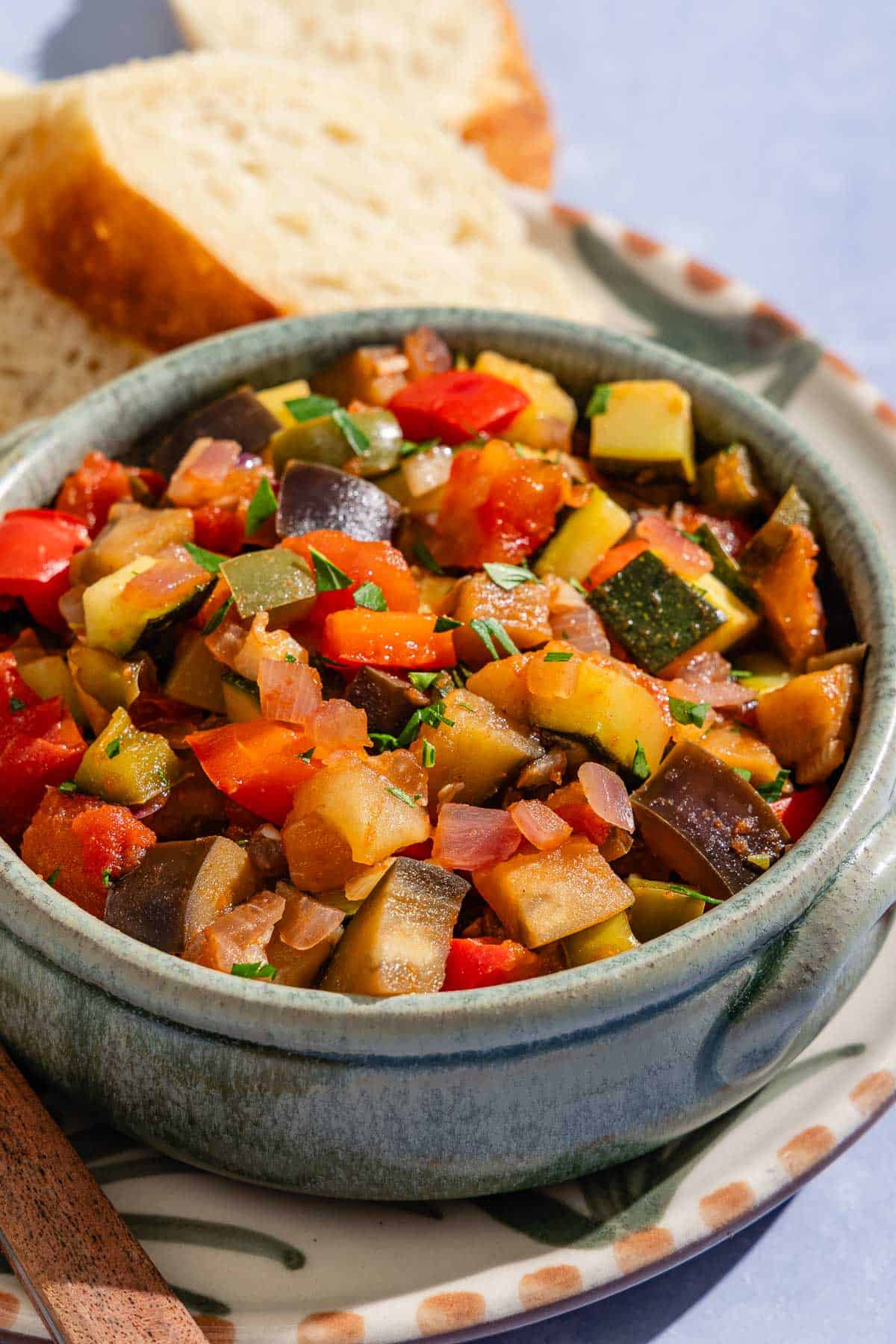
This is a dish where I take a light hand with the seasoning, keeping the focus on the flavors of the vegetables. I’m careful with the stewing to ensure they’re just tender without losing all their structure.
Even when summer ends, I don’t stop making pisto. In the winter or when I can’t get the best produce, I like to boost the flavor by using canned fire-roasted diced tomatoes, doubling the spices, and stewing the pisto for an extra 5 to 10 minutes until it’s soft and velvety.
Table of Contents
What is Pisto?
Think of pisto as Spain’s version of ratatouille. It’s a dish of stewed fresh vegetables. At its most basic, pisto is made with tomatoes, onions, and peppers. But like many old, classic Spanish recipes, there are countless variations throughout the different regions of Spain. The most common is pisto Manchego, or pisto from the region of La Mancha, which includes zucchini and sometimes eggplant.
In Spain’s typical multicourse lunches, pisto is often served as a first course. But it’s also popular as a side to roasted or grilled meat and seafood. I often look forward to a bowl of pisto as a light, but flavorful summer meal. When I want something more substantial, I add a fried or poached egg and some bread for dipping.
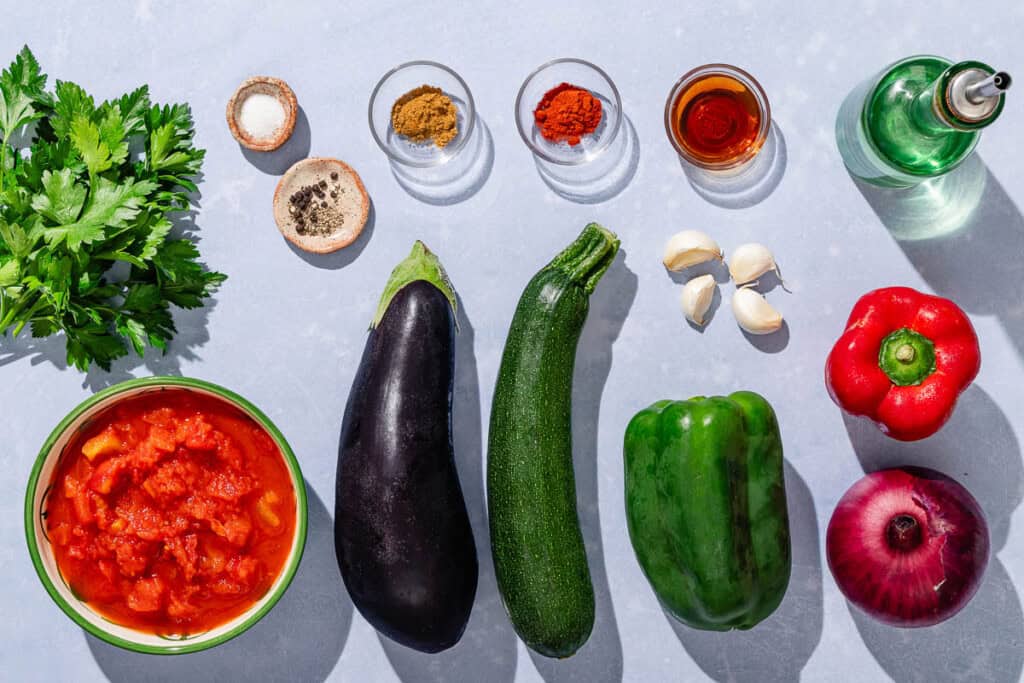
Ingredients for Pisto
A delicious pisto relies on summer produce at its peak. If you grow peppers or zucchini in your garden, this is the recipe to use them in. Here’s what you’ll need:
- Extra virgin olive oil: Use flavorful, high-quality extra virgin olive oil. Hojiblanca, with its peppery flavor, will bring out the best in the vegetables.
- Onion: I like to use red onion for its color and sweet flavor, but you can use a yellow onion if you prefer.
- Bell pepper: I like to use both red and green bell peppers for a variety of colors and flavors, but feel free to use any color you want.
- Garlic: I add lots of garlic, but as it cooks, it mellows and gives the vegetables a sweet and nutty flavor.
- Eggplant: Look for Italian eggplant, which is more tender than globe eggplant and has a robust flavor. Italian eggplant is a bit smaller than globe eggplants with a tear-drop shape. If you use a globe eggplant, you may only need to use half, depending on its size.
- Zucchini: Pisto is a great way to use flavorful, homegrown zucchini. In the store, look for smooth and firm zucchini. Any type of summer squash will work well in this recipe.
- Diced tomatoes: I usually save juicy, in-season tomatoes to eat fresh and instead opt for good-quality canned diced tomatoes. They have excellent flavor and don’t need any chopping. For a smoky flavor, you can use canned fire-roasted diced tomatoes.
- Sweet paprika: Sweet Spanish paprika has a warm, fruity flavor that packs a punch without any heat. I don’t add much to avoid overpowering the flavor of the vegetables. For out-of-season veggies, feel free to add more or use smoked Spanish paprika.
- Cumin has a warm, citrusy flavor that rounds out the taste of the stewed vegetables.
- Sherry vinegar: A splash of sherry vinegar added at the end of cooking brightens the pisto with some acidity. If you don’t have sherry vinegar, don’t skip it; substitute it with white or red wine vinegar or even a squeeze of lemon juice.
- Parsley: Stirring in a small handful of chopped fresh parsley adds herbaceous flavor to the pisto.
- Salt and pepper: Salt brings out all the flavors the vegetables have to offer, and freshly ground black pepper adds a hint of heat.
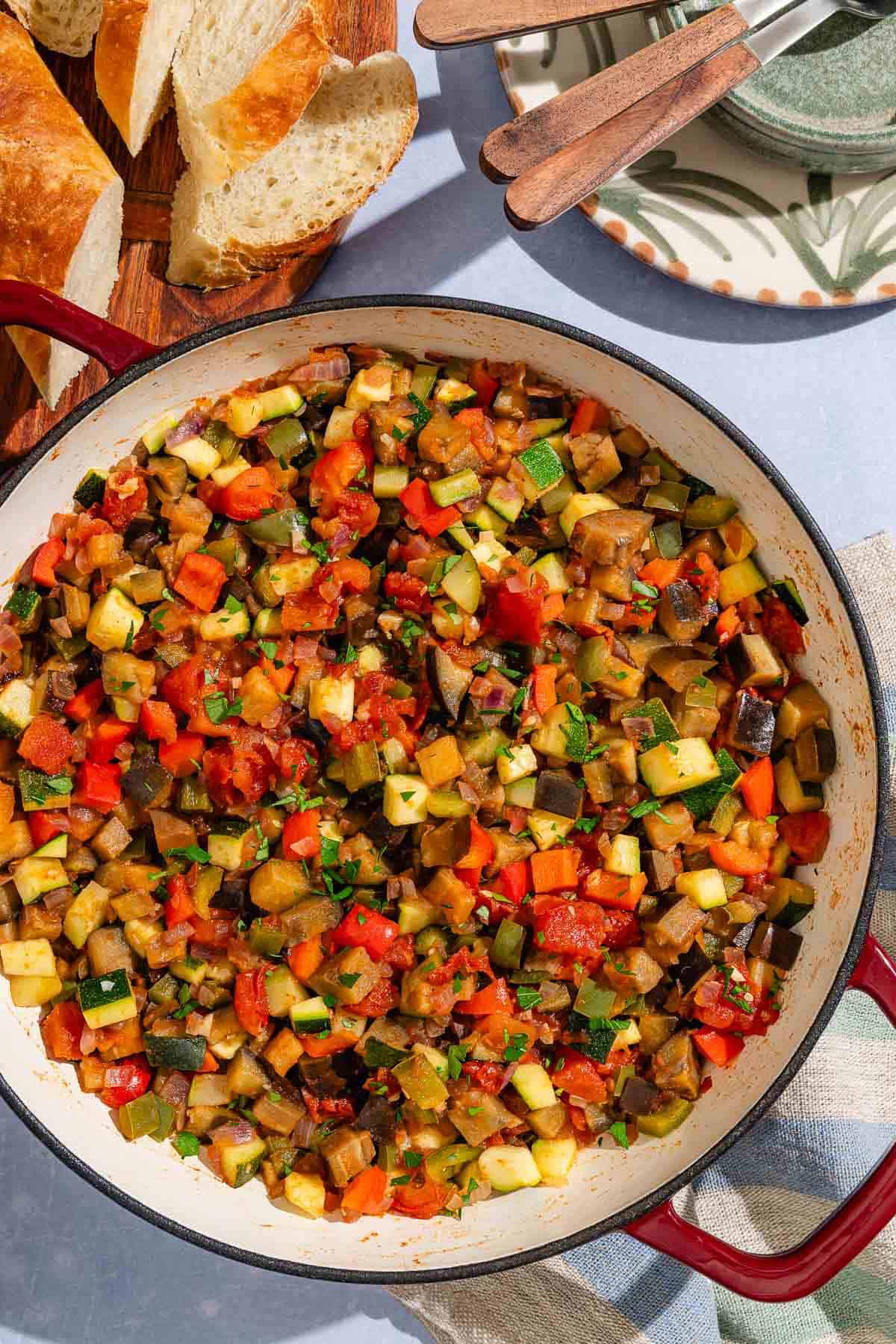
How to Make Pisto
The secret to the best pisto is adding the vegetables one by one to ensure each one is perfectly tender, but not mushy. Here’s how to make it:
- Cook the vegetables. Heat 1/4 cup extra virgin olive oil in a large pan over medium-high heat. Add 1 diced red onion and cook, stirring often, until softened, about 5 minutes. Keep stirring often as you add the remaining vegetables. Add 1 diced red bell pepper and 1 diced green bell pepper and cook for 4 minutes. Add 4 minced garlic cloves and cook until fragrant, about 30 seconds. Add the 1 eggplant, diced into 1/2-inch cubes, and cook for 3 minutes. Add 1 diced zucchini and cook until the vegetables begin to brown, about 3 minutes.
- Add the tomatoes and seasoning. Add 1 (14-oz) can diced tomatoes, 1 teaspoon sea salt, 1/4 teaspoon freshly ground black pepper, 1/2 teaspoon sweet Spanish paprika, and 1/2 teaspoon ground cumin. Reduce the heat to medium and cook the tomatoes down, stirring occasionally, until reduced and the vegetables are tender, about 10 minutes.
- Finish and serve. Remove the pan from the heat and stir in 1 tablespoon sherry vinegar and 2 tablespoons chopped fresh parsley. Serve the pisto in bowls with crusty bread as an appetizer or side dish with meat or fish. If you’d like to serve it as a main course, top it with a fried egg.
Ways to Make it Your Own
Pisto recipes vary in each region of Spain, but what unites all the different versions is the stewed tomatoes, peppers, and onions. Here are some variations you can try:
- Add potatoes: Some versions add potatoes either in addition to or instead of the eggplant or zucchini. After cooking the onions, add 1 pound of peeled potatoes, diced into 1/2-inch cubes.
- Stew it longer: Pisto is often stewed until very soft, and the flavors concentrate. I prefer to cook it less, for perfectly tender vegetables. But if you like the stewed version, reduce the heat to low after adding the tomatoes and cook, stirring occasionally, for 30 minutes or until the vegetables are soft.
- Add eggs: When served as a meal, pisto often comes with a fried or poached egg on top. In some areas, eggs are dropped directly into the pisto to poach, like with shakshuka. To do this, double the tomato so there’s enough juice to poach the tomatoes. After the tomatoes have simmered for 10 minutes, make an indentation in the pisto for each egg. Gently crack an egg into each indentation. Cover and cook on low until the egg whites are set.
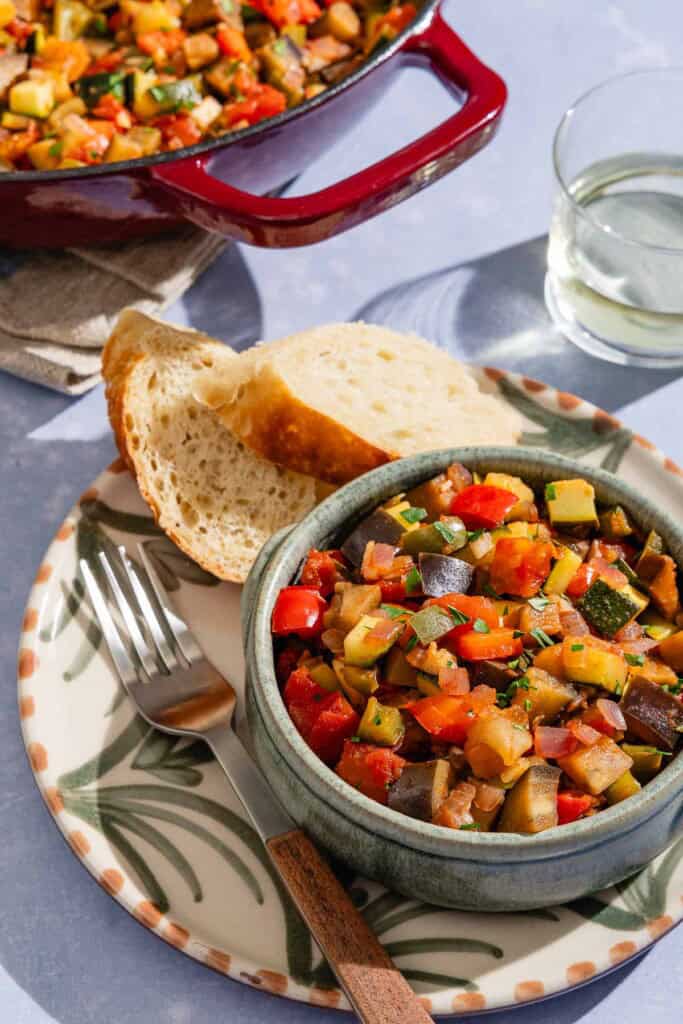
What to Serve with Pisto
Serve this pisto recipe as an appetizer with rustic bread for dipping. Add a fried or poached egg on top for a light meal, or spoon some pisto over a bowl of aromatic saffron rice.
Pisto is often served as a side for roasted or grilled meat or fish. Try it with simple, lemony grilled chicken or comforting roasted pork tenderloin. For a meal with fish, grill some marinated swordfish steaks, or serve the pisto alongside this lemon and garlic roasted salmon.
Love this recipe? Check out our collections of Spanish tapas and Spanish recipes for Summer!
More Vegetable Soups & Stews:
Mediterranean Diet Recipes
Homemade Vegetable Soup
Soups and Stews
Easy Ratatouille (One Pot Vegetable Stew)
Soups and Stews
Hearty Vegetable Stew
Vegetarian
Easy Moroccan Vegetable Tagine Recipe
Browse all Mediterranean recipes.
Visit Our Shop.
Pisto (Spanish Vegetable Stew)

Ingredients
- 1/4 cup extra virgin olive oil
- 1 medium red onion, diced
- 1 red bell pepper, diced
- 1 green bell pepper, diced
- 4 garlic cloves, minced
- 1 eggplant, diced into 1/2-inch cubes
- 1 zucchini, diced into 1/2-inch cubes
- 1 14-ounce can diced tomatoes
- 1 teaspoon sea salt
- 1/4 teaspoon freshly ground black pepper
- 1/2 teaspoon sweet Spanish paprika
- 1/2 teaspoon ground cumin
- 1 tablespoon sherry vinegar
- 2 tablespoons chopped fresh parsley
- Fried or Poached Eggs (optional)
- Crusty bread (optional), to serve
Instructions
- Cook the vegetables. Heat the olive oil in a large pan over medium-high heat. Add the onion and cook, stirring often, until softened, about 5 minutes. Keep stirring often as you add each vegetable. Add the bell peppers and cook for 4 minutes. Add the garlic and cook until fragrant, about 30 seconds. Add the eggplant and cook for 3 minutes. Add the zucchini and cook until the vegetables begin to brown, about 3 minutes.
- Add the tomatoes and seasoning. Add the canned diced tomatoes, salt, black pepper, paprika, and cumin. Reduce the heat to medium and cook the tomatoes down, stirring occasionally, until reduced and the vegetables are tender, about 10 minutes.
- Finish and serve. Remove the pan from the heat and stir in the sherry vinegar and parsley. Serve the pisto in bowls with crusty bread as an appetizer or side dish with meat or fish. If you’d like to serve it as a main course, top it with a fried egg.
Notes
- Shop this recipe: Visit our shop to browse quality Mediterranean ingredients including the olive oil, cumin, and paprika used in this recipe.



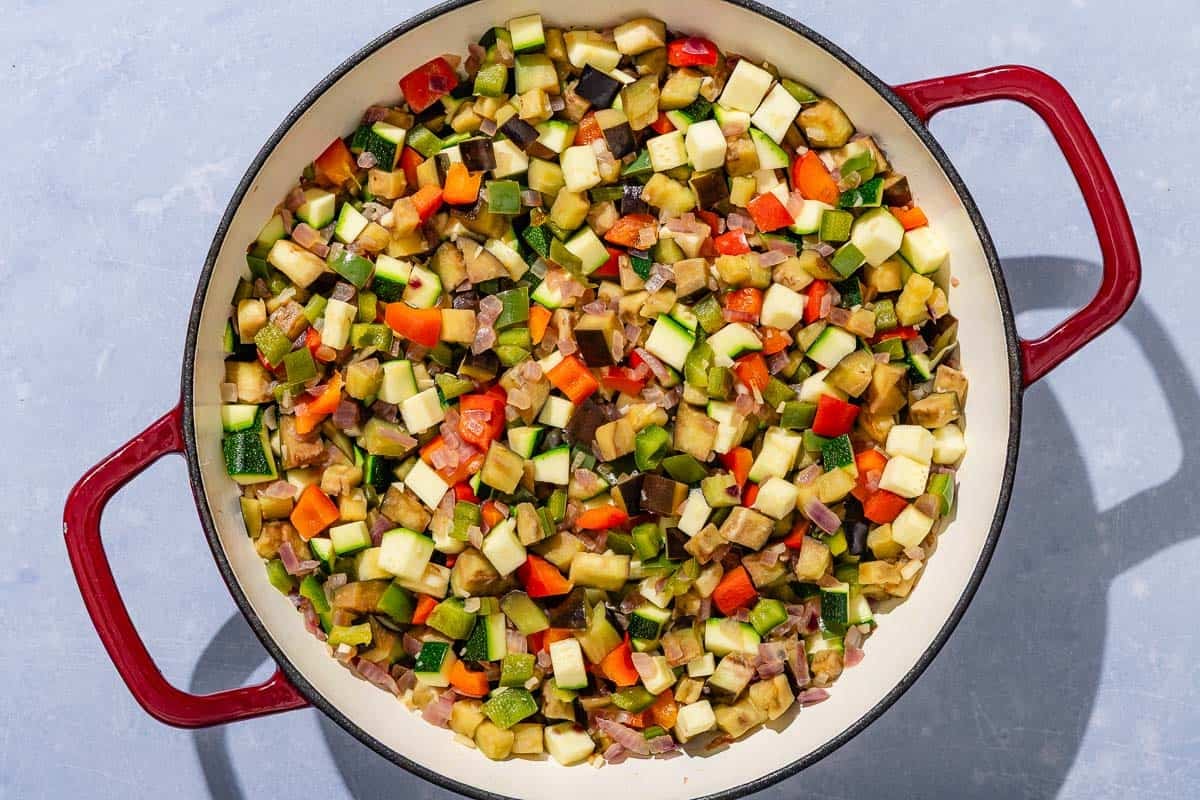
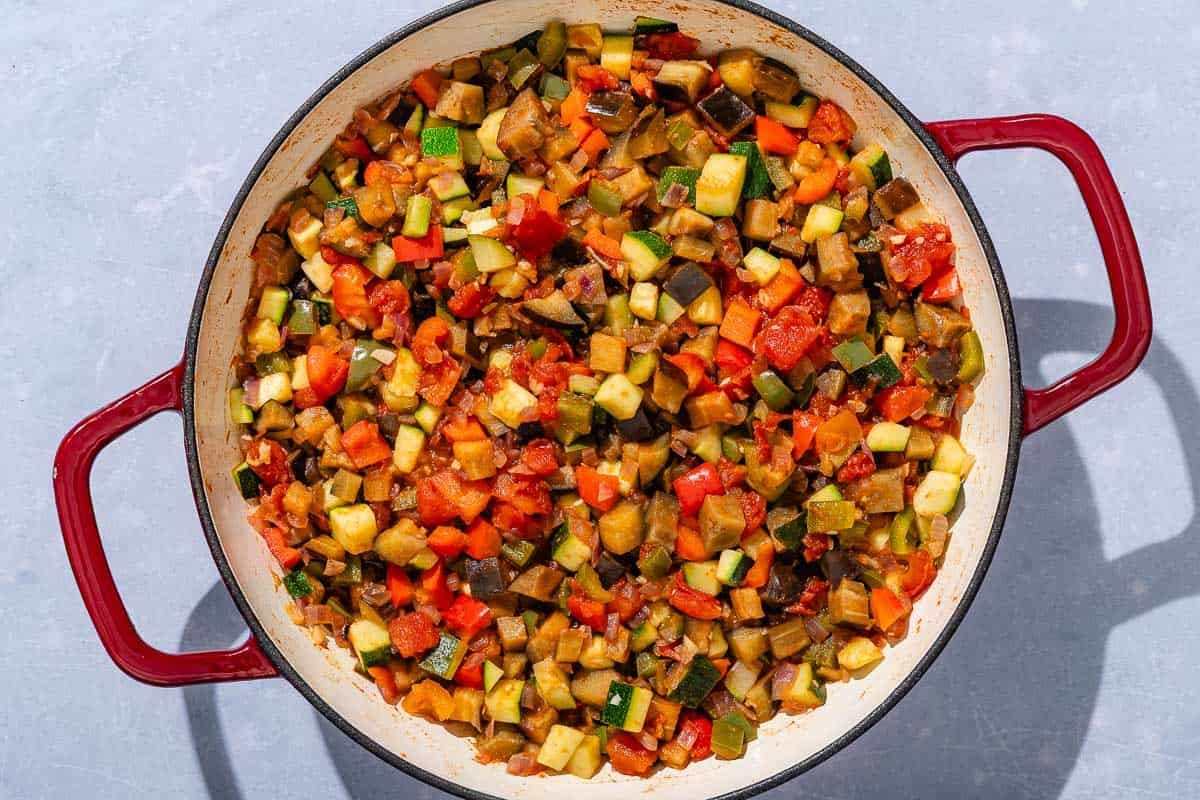
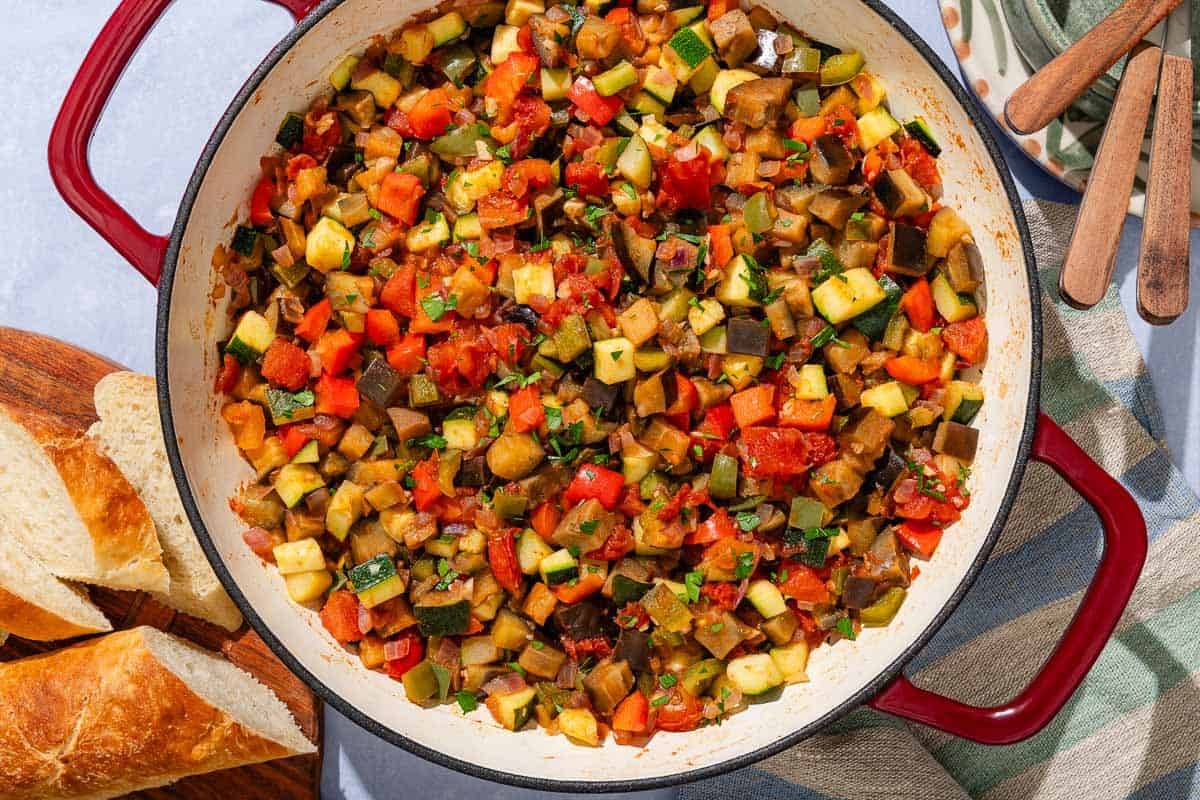

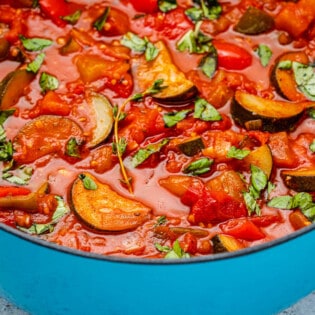
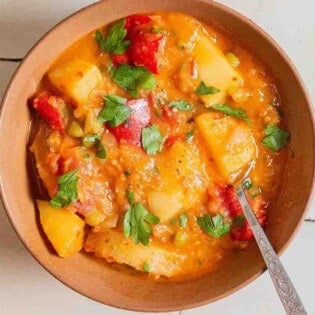
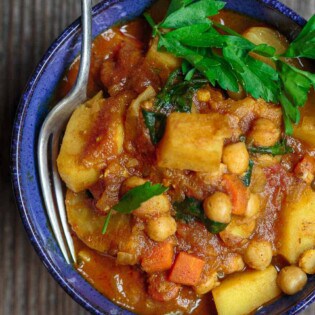
Excellent
This was a delicious change from Italian/ Provincial ratatouille. The spices are perfect as is the tang from the sherry vinegar. My husband ate it even knowing it had eggplant in it. A very good sign that this is a keeper
Yesss! That’s definitely a win!
Muy interesante, saludables deliciosa nada complicada facilita el acompañamiento con varios elementos a gusto .